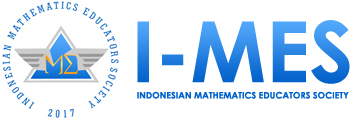Literasi Matematis Mahasiswa Calon Guru dalam Menyelesaikan Soal Numerasi Statistik Berdasarkan Gaya Belajar Honey-Mumford
DOI:
https://doi.org/10.35706/sjme.v7i2.7757Abstract
This study aims to describe students' mathematical literacy skills in solving statistical literacy questions based on Honey-Mumford learning styles. The statistical literacy questions used in this study are questions of the AKM type which are related to statistical material about the size of data concentration. The subjects of this study were first semester students of the Department of Mathematics, State University of Malang. The instruments used in data collection were test questions, interview guidelines, and instrument validation sheets. The results of the study show that there are differences in the level of students' abilities in several aspects that become competencies in mathematical literacy. Students with a reflective learning style tend to be more detailed in terms of using symbols and mathematical formulas, students with a theoretical learning style tend to be more thorough in understanding and translating the meaning of the questions, while students with a pragmatic learning style tend to prefer using simple reasoning with minimal use of mathematical symbols/formulas.
Downloads
References
Abidin, Yunus, dkk. (2017). Pembelajaran Literasi. Jakarta: Bumi Aksara.
Aljaberi, N. M. (2014). Pre-Service Elementary School Teachers’ Learning Styles and Their Ability to Solve Mathematical Problems According to Polya's Strategy. Journal of Education and Practice, 5(30), 150-162.
Anwar, N. T., Waluya, S.B., & Supriyadi. (2018). Kemampuan Literasi Matematika Berdasarkan Self-Confidence Pada Pembelajaran Berbasis Masalah dengan Proses Pemecahan Masalah DAPIC. Unnes Journal of Mathematics Education Research, 7 (2): 152-160.
Arikunto, Suharsimi. (1987). Dasar-Dasar Evaluasi Pendidikan. Jakarta: Bumi Aksara.
Bahrul Hayat & Suhendra Yusuf. (2010). Mutu Pendidikan. Jakarta : Bumi Aksara.
Budiono, C.S., Wardono. 2014. PBM Berorientasi PISA Berpendekatan PMRI Bermedia LKPD Meningkatkan Literasi Matematika Siswa SMP. Unnes Journal of Mathematics Education, 3(3): 209-219.
Bungin, Burhan. (2001). Metodologi Penelitian Kualitatif. Surabaya: Rajawali Pers.
Creswell, J. (2012). Educational Research: Planning, Conductioning, and Evaluating Quantitative and Qualitative Research 4th Edition. Boston: Pearson.
Edimuslim, E, dkk. (2019). Analisis Kemampuan Literasi Matematika Ditinjau dari Gaya Belajar. Journal of Mathematics Education. 5(2) : 95.
Damrongpanit, S. (2014). An Interaction of Learning and Teaching Styles Influencing Mathematics Achievements of Ninth-Grade Students: A Multilevel Approach. Academic Journal, 9(19), 771-779.
Duff, A. & Duffy, T. (2002). Psychometric Properties of Honey & Mumford’s Learning Styles Questionnaire (LSQ). Personality and Individual Differences, 33, 147–163.
Fatma, Maulida R.A. (2018). Kemampuan Literasi Matematika Ditinjau dari Gaya Belajar dan Gender Peserta Didik Pada Pembelajaran PBL Berbantuan Asesmen Proyek. Semarang : UNS.
Honey, P., & Mumford, A. (1989). Learning Styles Questionnaire. Organization Design and Development, Incorporated.
Hudojo, H. (2003). Pengembangan Kurikulum dan Pembelajaran Matematika. Malang: JICA-FMIPA UM.
Johar, Rahmah. (2012). Domain Soal PISA Untuk Literasi Matematika.
Kemendikbud. (2013). Materi Pelatihan Guru Matematika SMP/MTs tentang Implementasi Kurikulum 2013. Jakarta : Kemendikbud.
Kusmaryono, I., Suyitno, H., Dwijanto. (2016). The Role Of Mathematical Representation and Disposition in Improving Students’ Mathematical Power. AdMathEdu, 6(1): 11-24.
Lexy J. Meleong. (2005). Metodologi Penelitian Kualitatif. Yogyakarta: Remaja Rosda Karya,
Mujulifah, Fithri. (2015). Literasi Matematis Siswa Dalam Menyederhanakan Ekspresi Aljabar. Jurnal Pendidikan Dan Pembelajaran 4.
OECD. (2013). PISA 2012 Assessment and Analytical Framework: Mathematics, Reading, Science, Problem Solving and Financial Literacy. Paris: OECD Publisher
OECD. (2016). PISA 2015 Assessment and Analytical Framework: Science, Reading, Mathematic and Financial Literacy. PISA. Paris : OECD Publisher.
OECD. (2019). PISA 2018 Results: Combined Executive Summaries. Volume I, II & III. PISA. Paris : OECD Publisher.
Ojose, Bobby. (2011). Mathematics Literacy: Are We Able to Put the Mathematics We Learn into Everyday Use.‖ Journal of Mathematics Education. 4, 1 : 89–100.
Paridjo dan Budi Waluya. (2017). Analysis Mathematical Communication Skill Students In The MatterAlgebra Based Nctm.
Pritchard, A. (2009). Ways Of Learning: Learning Theorist And Learning Styles In The Classroom 2nd Edition. New York: Routledge.
Santrock, J. W. (2011). Educational Psychology 5th Edition. New York: McGraw Hill.
Sari, Rosalia Hera Novita. (2016). Kemampuan Literasi Matematika Siswa SMA Di Daerah Istimewa, Yogyakarta : UNY.
Stori, Djaman. (2014). Metodologi Penelitian Kualitatif. Bandung: Alfabeta.
Sugiyono. (2014). Metode Penelitian Kualitatif Kuantitatif Dan R&D. Bandung: Alfabeta.
Swailes, S. & Senior, B. (1999). The Dimensionality of Honey and Mumford’s Learning Style Questionnaire. International Journal of Selection and Assessment, 7(1), 1-11.
Yustitia, Via. (2019). Literasi Matematika Mahasiswa dengan Gaya Belajar Visual. Journal of Mathematics Education. 9(1), 1-13.
Downloads
Published
How to Cite
Issue
Section
License

This work is licensed under a Creative Commons Attribution-ShareAlike 4.0 International License.
Authors who publish with this journal agree to the following terms:
- Authors retain copyright and grant the journal right of first publication with the work simultaneously licensed under a Creative Commons Attribution License that allows others to share the work with an acknowledgment of the work's authorship and initial publication in this journal.
- Authors are able to enter into separate, additional contractual arrangements for the non-exclusive distribution of the journal's published version of the work (e.g., post it to an institutional repository or publish it in a book), with an acknowledgment of its initial publication in this journal.
- Authors are permitted and encouraged to post their work online (e.g., in institutional repositories or on their website) prior to and during the submission process, as it can lead to productive exchanges, as well as earlier and greater citation of published work (See The Effect of Open Access).












